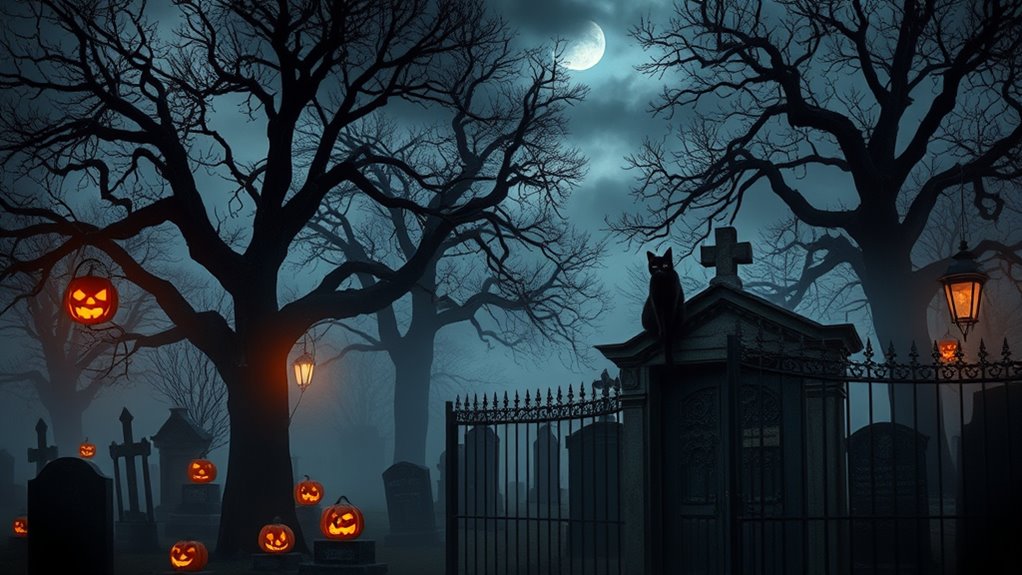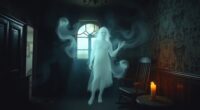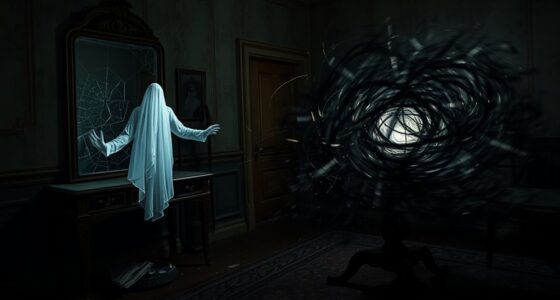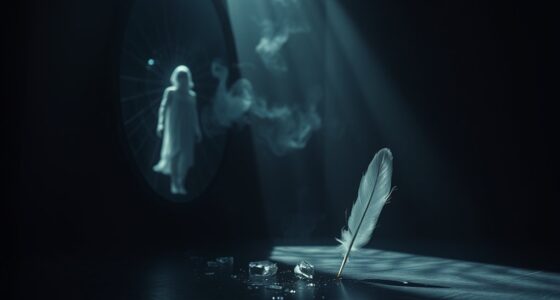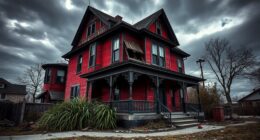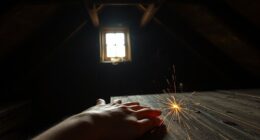The most haunted time of year is Halloween. This season, steeped in supernatural lore and ghostly tales, captures your imagination like no other. It marks the end of harvest and the onset of winter, a time when the veil between worlds is believed to thin. As you explore chilling stories and eerie traditions, you’ll discover how this vibrant season evolved from ancient customs. Curious about the fascinating connections and customs that shape Halloween? There’s much more to uncover.
Key Takeaways
- Halloween, celebrated on October 31st, is widely regarded as the most haunted time of year, steeped in supernatural traditions and folklore.
- The witching hour, between midnight and 1:00 am, is believed to peak supernatural activity, contributing to the eerie atmosphere of Halloween.
- Folklore and ghost storytelling traditions thrive during Halloween, reflecting societal fears and cultural beliefs about the supernatural.
- The connection between Halloween and Christmas highlights the spectral themes in both holidays, emphasizing the haunted nature of the autumn season.
- Autumn’s arrival creates an eerie backdrop, inviting reflection and storytelling, enhancing Halloween’s allure as the most haunted time of year.
The Origins of Halloween
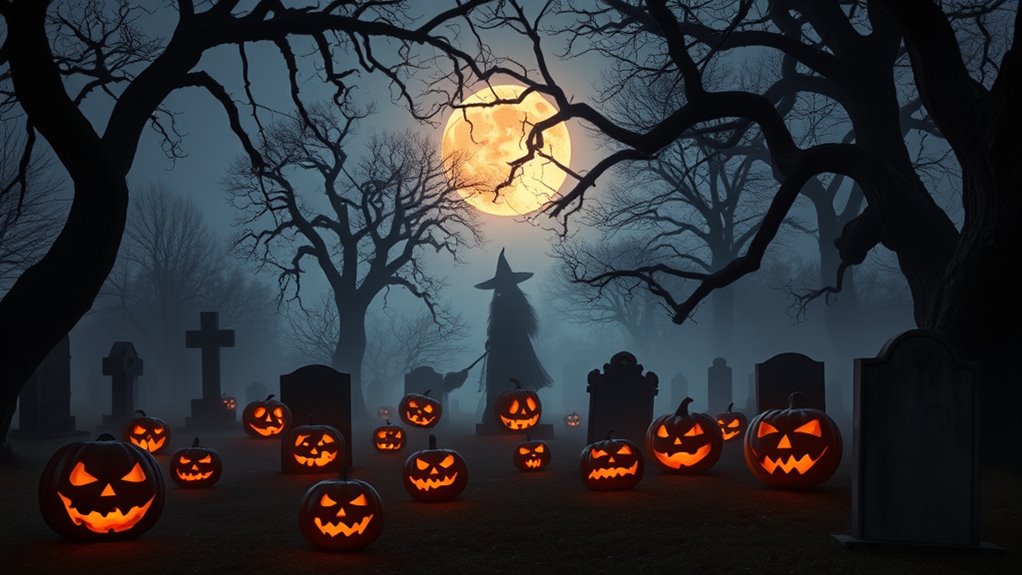
As the leaves change and the nights grow longer, you might wonder about the origins of Halloween. This spooky celebration, also known as All Hallows’ Eve, traces back to ancient Celtic festivals, especially Samhain, which marked the harvest’s end and winter’s onset.
During this time, people believed the veil between worlds thinned, allowing supernatural beings like witches and goblins to roam freely. Halloween evolved over the years, blending customs from the Roman festival of Pomona and the Christian observance of All Saints’ Day.
Today, traditions like carving jack-o-lanterns, influenced by Irish immigrants, add to the festive atmosphere. Understanding Halloween’s roots helps you appreciate the rich history and cultural significance behind the eerie celebrations you enjoy each year.
The Witching Hour: Supernatural Significance
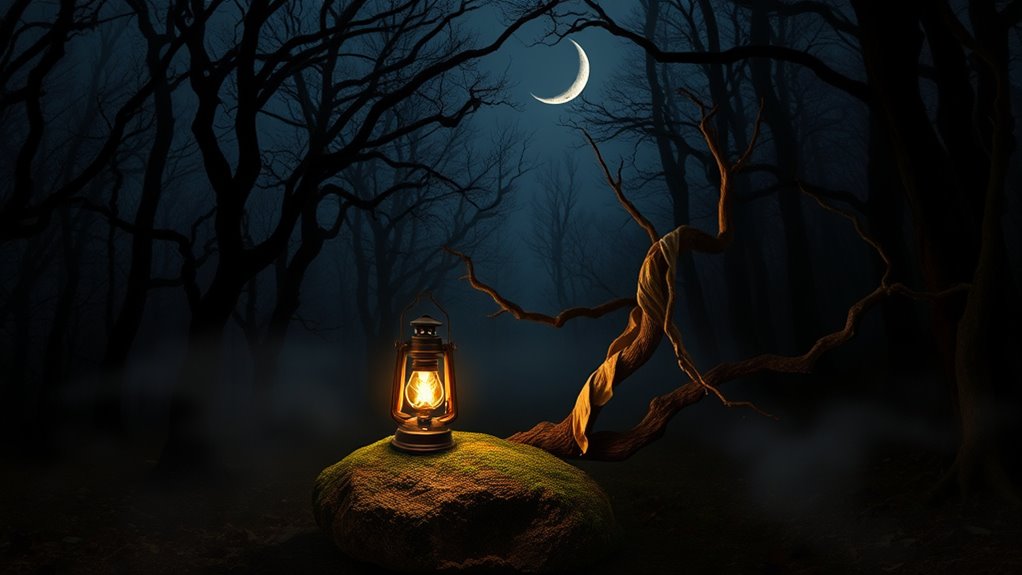
As the clock strikes midnight, you enter the witching hour, a time steeped in historical beliefs and folklore about supernatural forces at play.
This hour not only heightens your senses but also coincides with physiological changes in your body that affect sleep and awareness.
It’s no wonder that many associate this mystical time with both eerie happenings and a sense of danger.
Historical Beliefs and Folklore
Though many may dismiss it as mere superstition, the concept of the “witching hour” holds a significant place in historical beliefs and folklore.
This term, dating back to 1762, refers to the eerie time between midnight and 1:00 am when supernatural activity supposedly peaks. Stories of witches and their midnight rituals have permeated cultures, echoing Shakespeare’s reference to the “very witching time of night.”
Ghost stories often emerge from this hour, as heightened apparitional experiences are said to occur during the early morning. Additionally, crime statistics show a spike in violence around this time, reinforcing its dark reputation.
For many, the witching hour remains a time of fear and fascination, steeped in centuries of tradition and eerie tales.
Physiological Effects on Sleep
The witching hour, wrapped in tales of supernatural occurrences, also has a profound physiological impact on sleep. This mysterious time, often between 12:00 am and 1:00 am, coincides with REM sleep, where your heart rate slows and breathing becomes irregular.
If you wake suddenly, you might feel fear and disorientation, intensifying the effects of ghost stories that haunt your thoughts. Research shows that nightmares and sleep paralysis are more common during this hour, linked to your body’s natural circadian rhythm.
As cortisol levels decrease, feelings of unease can rise, particularly between 2:00 am and 4:00 am, when apparitional experiences are heightened. These physiological effects can make any existing ailments feel much worse, deepening your connection to the supernatural.
The Role of Folklore in Haunting Tales

Folklore shapes haunting tales by mirroring cultural beliefs and societal fears about the supernatural, especially during Halloween when ghost stories and witchcraft take center stage. Many haunting tales come from oral traditions, reflecting local values and fears, particularly in the dark winter evenings.
The Victorian era marked a shift to written ghost stories, driven by increasing literacy, which also popularized themes of the supernatural. Authors like Charles Dickens cleverly wove folklore into their narratives, blending morality and redemption in tales that resonate with the spirit of Christmas ghost stories.
These folkloric elements often serve as cautionary reminders, highlighting issues of morality, loss, and the consequences of one’s actions—timeless themes that echo strongly during this haunting season.
Autumnal Atmosphere and Its Influence

As the weather shifts and the days grow shorter, you can feel the excitement of autumn in the air.
Festive decorations start to appear, setting the stage for gatherings filled with ghost stories and seasonal traditions.
This atmospheric change not only sparks your imagination but also connects you to the rich storytelling heritage of this haunting time. The season’s emotional intensity can evoke memories of chronic feelings of emptiness that resonate with many, amplifying the allure of ghostly tales and folklore.
Changing Weather Patterns
While the arrival of autumn often signals the end of warm, sunny days, it also ushers in a unique atmosphere that invites reflection and storytelling. The shorter days and longer nights create an eerie backdrop, perfect for ghost stories. As cooler temperatures set in and leaves change, you can’t help but feel a sense of shift. This season historically connects to folklore traditions, celebrating the thinning veil between the living and the dead. Foggy evenings and early darkness enhance the haunting ambiance, making it a prime time to explore haunted attractions. Additionally, the emotional toll of virtual affairs can resonate with the heightened feelings people experience during this time. Furthermore, many cultures have long associated this season with supernatural lore that emphasizes the connection between life and death. Spiritual retreats during this time often provide spaces for mindfulness practices that can help individuals process these emotions. Moreover, as the days grow shorter, many find solace in classical music that promotes relaxation and better mood regulation, further enhancing the reflective nature of the season.
Plus, the psychological effects of longer nights can heighten your emotions, drawing you closer to the macabre and the chilling tales that accompany it. During this time, many may also experience heightened feelings of emotional instability, similar to those faced by individuals dealing with Borderline Personality Disorder.
Festive Decorations Emerge
With autumn’s arrival, festive decorations begin to emerge, transforming homes and neighborhoods into vibrant displays of seasonal spirit.
As the days grow shorter and temperatures cool, the atmosphere sets the stage for Halloween’s spooky allure. You’ll notice:
- Jack-o-lanterns glowing with eerie faces, inviting ghost stories to be shared.
- Ravens perched on porches, symbolizing freedom and the supernatural.
- Haunted houses popping up, enticing thrill-seekers to explore folklore.
- Spooky landscapes adorned with ghosts, enhancing the excitement leading to Halloween.
These decorations not only mark the shift into autumn but also create an atmosphere that encourages storytelling and reminiscing about ghostly tales — a perfect prelude to the festive cheer of Christmas ahead.
Seasonal Storytelling Traditions
When the cool autumn air settles in, people naturally gravitate toward the warmth of storytelling, especially ghost stories that thrive in the season’s eerie ambiance.
As days shorten and temperatures drop, gathering indoors creates the perfect backdrop for sharing spine-chilling tales. The tradition of ghost stories during autumn dates back to historical practices around the winter solstice, where long, dark nights encouraged communities to huddle by the fire, exchanging spooky narratives.
In Victorian England, the rise of printed ghost stories made these tales accessible to everyone, regardless of social class.
Today, Halloween amplifies this cultural custom, inviting families and friends to bond over shared scares, ensuring that the chilling tradition of storytelling continues to thrive.
Ghost Storytelling Traditions Across Cultures
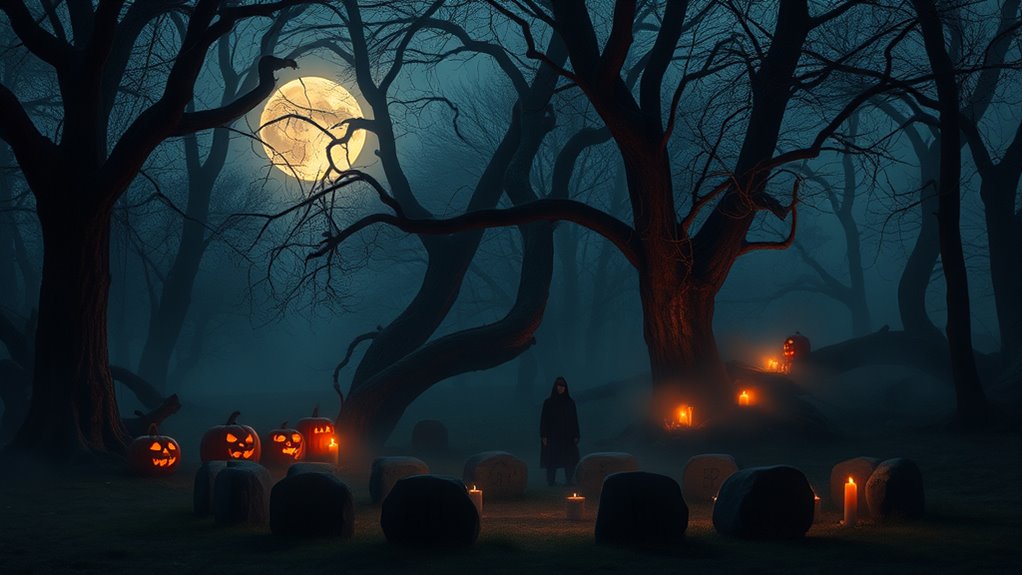
As the nights grow longer during the winter solstice, cultures around the world embrace the tradition of ghost storytelling, gathering by the fire to share chilling tales.
These ghost stories connect generations, allowing everyone to participate regardless of literacy. Here are some emotional highlights of these haunting traditions:
- Shared Fear: The thrill of a ghost story brings people together, creating a bond through shared chills.
- Cultural Heritage: Each story carries the essence of its culture, preserving history and folklore for future generations.
- Moral Lessons: Many ghost tales weave in themes of forgiveness and redemption, offering life lessons wrapped in supernatural elements.
- Connection to Nature: The long, dark nights of winter amplify the eerie ambiance, enhancing the storytelling experience.
These traditions remind you that the past is never truly gone.
The Impact of Industrialization on Ghost Stories
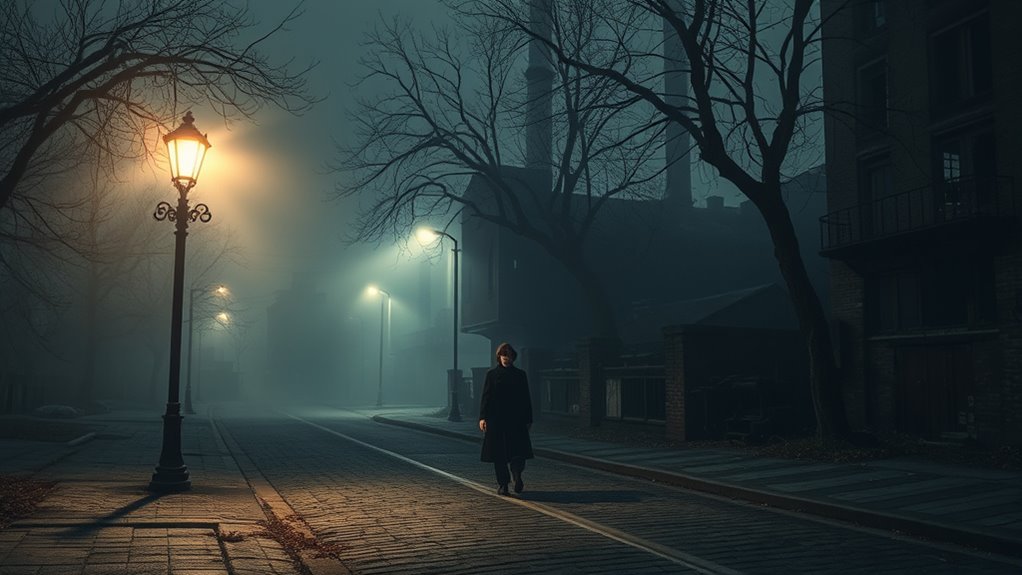
Though industrialization transformed society in many ways, it also reshaped the landscape of ghost stories, turning them from oral traditions into written narratives.
The Victorian era, fueled by the Industrial Revolution, saw the rise of cheaper printing costs and increased literacy rates. Suddenly, ghost stories could be published in periodicals and magazines, reaching wider audiences.
The Victorian era’s industrial advancements democratized ghost stories, allowing them to flourish in print and captivate broader audiences.
As people migrated to urban areas, they craved familiar supernatural tales set against the backdrop of new industrial landscapes. Editors enthusiastically sought these ghost stories, leading to an explosion of written narratives.
The societal anxieties of the time also spurred interest in darker themes, intertwining the supernatural with the realities of industrial life, and ensuring ghost stories remained relevant in this changing world.
The Evolution of Halloween Customs
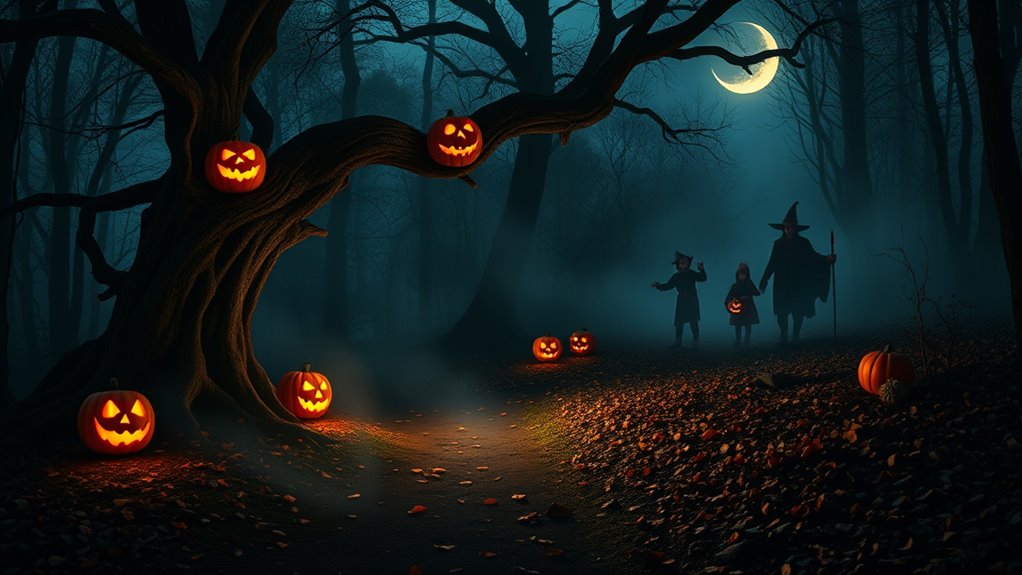
While the origins of Halloween are steeped in ancient traditions, its customs have undergone significant transformations over the centuries. You might be surprised to learn how these changes reflect both our fears and our fun:
- Ancient Celts lit bonfires to blur the line between the living and the dead, sparking ghost stories that still haunt us.
- The tale of Stingy Jack led to the iconic jack-o-lantern, a symbol of mischief and light.
- The Victorian era shifted Halloween to a community celebration, embracing rather than fearing the supernatural.
- Trick-or-treating emerged in the U.S., blending European customs with children’s delight for candy.
Today, Halloween stands as a cultural phenomenon, blending old fears with modern festivities, and it’s hard not to feel the thrill in the air.
The Connection Between Halloween and Christmas

Halloween and Christmas, though seemingly worlds apart, share intriguing connections that reveal how our culture grapples with the supernatural.
Halloween, celebrated on October 31st, kicks off the spooky season with ghosts and witches, while Christmas, shaped by Victorian traditions, also embraces ghost stories, especially through works like Dickens’ *A Christmas Carol*.
These narratives, while different in tone—Halloween’s eerie folklore versus Christmas’s moral lessons—highlight our fascination with the supernatural.
The oral tradition of ghost stories thrived during the long winter nights, leading to their commercialization in the 19th century.
Both holidays showcase how tales of spirits and the afterlife resonate with us, reminding us of the thin line between celebration and the spectral domain. Additionally, it is these awkward moments that often become the most memorable stories shared during both holidays.
Modern Hauntings: Urban Legends and Myths
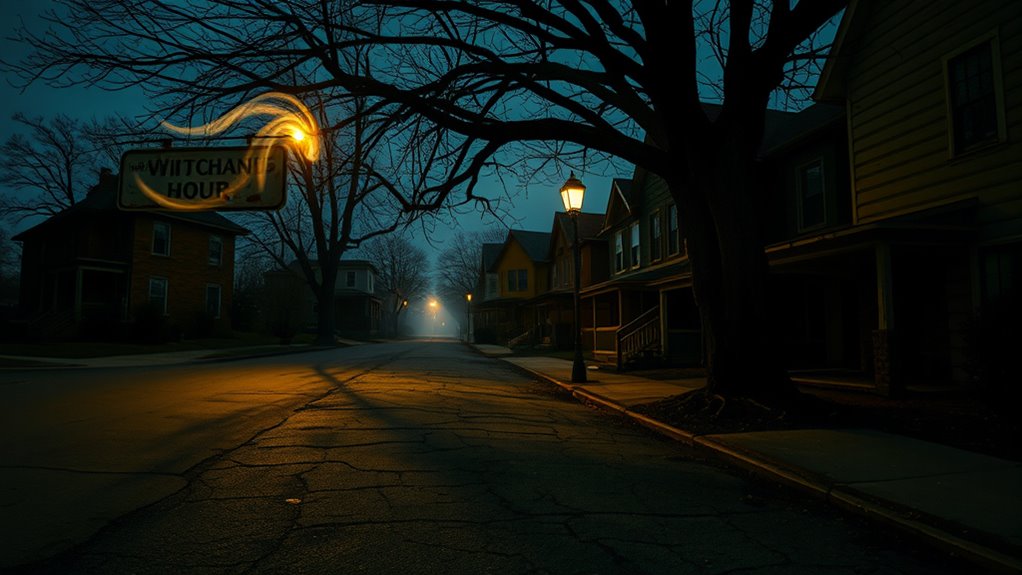
As Halloween approaches, you might find yourself hearing local urban legends that send chills down your spine.
Exploring haunted places has become a thrilling pastime, with stories of ghostly encounters popping up everywhere.
With social media amplifying these myths, it’s easy to get caught up in the excitement of modern hauntings that blend fact and fiction.
Local Urban Legends
Urban legends thrive in the shadows of our cities, where stories of modern hauntings intertwine with local lore.
These ghost stories often stem from chilling tales passed down through generations. You might hear about:
- A haunted house where whispers echo in empty rooms.
- An abandoned building that locals swear is cursed.
- A ghostly figure seen wandering the streets late at night.
- A legend about a tragic event that forever altered a neighborhood.
Social media fuels these legends, enabling rapid sharing of eerie encounters.
Seasonal events, especially around Halloween, spark renewed interest, as you and your friends search for spine-tingling tales to share.
Each story invites you deeper into the thrill and mystery of your community’s haunted past.
Haunted Places Exploration
When exploring haunted places, you’ll often find that the stories behind them are just as enchanting as the sites themselves. Urban legends thrive around these locations, weaving ghost stories that captivate the imagination.
The Winchester Mystery House in California is a prime example, where tales of ghostly apparitions add to its allure. In cities like New Orleans, ghost tours guide you through haunted sites, revealing rich histories of voodoo and supernatural occurrences.
The eerie ambiance of the Stanley Hotel in Colorado draws visitors in, while the Eastern State Penitentiary in Philadelphia offers chilling insights into its dark past.
These myths not only enchant tourists but also boost local economies, especially during the Halloween season when interest in haunted explorations peaks.
Celebrating the Supernatural: Events and Activities

Have you ever wondered how communities come alive with supernatural celebrations as Halloween approaches? This time of year is magical, steeped in traditions that embrace the eerie and the unknown.
You’ll find events that spark your imagination and celebrate ghost stories that chill the spine. Here are a few ways to immerse yourself in this spooky season:
- Haunted Houses – Experience heart-pounding thrills in creatively designed scare zones.
- Ghost Tours – Uncover local legends and eerie tales while exploring haunted sites.
- Costume Parties – Dress up as your favorite supernatural being and join the fun.
- Pumpkin Carving Contests – Show off your artistic side with spooky designs.
These activities not only entertain but also deepen your connection to the supernatural folklore that enriches our culture.
Frequently Asked Questions
What Time Is the Scariest Time?
The scariest time can be around the witching hour, typically between midnight and 1:00 am.
During these hours, you might feel an eerie chill as supernatural activity is believed to peak.
Plus, if you’re awake, you could experience heightened emotions from nightmares or sleep disturbances.
Statistically, dark events like violent crimes also spike during this time, adding to the unsettling atmosphere.
What Is the Devil’s Time?
You’re creeping through a dark, flickering-lit corridor, and suddenly it strikes 3:00 am—often called the Devil’s Time.
This hour’s notorious for supernatural activity, as folklore suggests witches and dark spirits are most potent then.
It’s believed to invert the Holy Trinity, stirring fear and unease.
With sleep disturbances like nightmares peaking during this time, you can’t help but feel a chill, as if the shadows themselves are watching your every move.
Is 3:33 a Demonic Time?
You might wonder if 3:33 am is a demonic time, and many believe it is.
This hour’s connection to the crucifixion of Christ makes it seem like a mockery of that sacred moment, leading to its spooky reputation.
People often report heightened fear or strange experiences when waking around this time, possibly due to REM sleep cycles.
Why Is 3am the Creepy Hour?
3 AM creeps in like a shadowy figure lurking just out of sight.
This hour is often linked to supernatural occurrences because your body’s in deep sleep, making you more susceptible to fear and disorientation.
With heightened melatonin levels and REM sleep, your mind can conjure vivid nightmares.
Historical beliefs also suggest it’s when the veil between the living and the dead is thinnest, intensifying the eerie atmosphere surrounding this unsettling hour.
Conclusion
As the leaves crunch beneath your feet and the air turns crisp, you can’t help but feel that tingle of excitement. You might find it curious how you bump into an old friend just as night falls, sharing ghost stories that send shivers down your spine. Isn’t it strange how Halloween draws us together, weaving tales of the supernatural into our lives? This season, embrace the magic and mystery—it’s the perfect time to explore what haunts us all.
